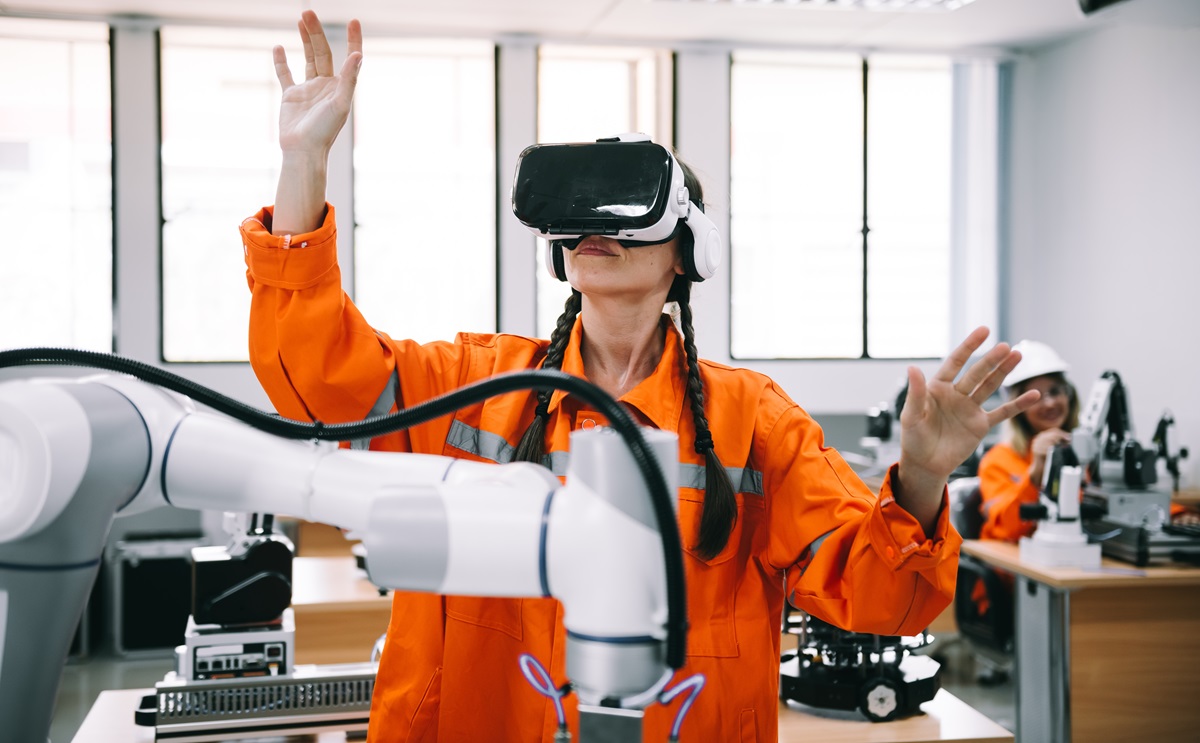Virtual reality for Robotics Engineering Education

Recently, robotics has become a crucial field for engineering and manufacturing because of the flexibility in executing numerous tasks or executing a given task in myriad ways. Considering this, universities have made robotics a part of their curriculum and research.
Though present textbooks and robot manuals include only the images of the robot, descriptions of robotic motions and the tasks that robots can perform within its programming samples.
Furthermore, teaching robotic engineering faces challenges coupled with the limited accessibility to high-end equipment crucial for translating theoretical concepts into practical applications.
As a result, students find it onerous in understanding the real tasks of the robot without doing hands on exercises. And to learn robotics effectively, it needs the basic equipment which is a robot.
Although, it’s an expensive approach for educational institutions to make it available for every student to perform robotics experimentation, plus robots are fragile and need careful handling.
Enhancing Learning - VR in Robotics Engineering
Virtual reality for robotic engineering creates an immersive and interactive simulation of a real or imagined environment, allowing students to visualize, manipulate, and test robotic systems in a realistic and interactive way.
Here is a quick synopsis of how a virtual environment translates the benefits of VR in robotics into a practical and interactive learning experience for learners.
● Offer students hands-on practice with contemporary robots through a virtual environment, developed using VR technologies.
● Foster a deep understanding of complex robot systems, encouraging students to uncover the principles behind each component instead of treating them as black boxes.
● Provide opportunities to hone integrative thinking skills through practical exercises with these robot systems.
● Enable students to grasp the essence of technological transformation in the Fourth Industrial Revolution and the associated learning opportunities. Validate these intentions through a short-term online workshop implementation.
Adhering to this, students can experience robotic systems from different perspectives and scales, interact with its elements using natural gestures and commands, and also learn how to operate, maintain or repair it.
Challenges and Solutions in Robotics Engineering

Let's dive a little deeper and discover how it effectively addresses the challenges in robotics education.
Challenge 1: During learning practices, improper handling and operations by students can damage the robots.
Solution:
Robots are expensive, but creating robots in a virtual environment with useful visualization tools and operation instructions can easily address this challenge.
Besides, one aspect of virtual reality is their potential to create a visualization of the robotic model and their corresponding objects along with movements in an immersive environment that is synonymous to managing a robot in real life.
In essence, students benefit from a realistic experience in visualizing and modeling robots, which is particularly valuable in robotics training in VR.
This approach not only reduces analysis and study time but also fosters a comprehensive understanding of the teaching material. The virtual robot laboratory plays a crucial role by providing visualization and simulation of robots in a virtual environment.
This includes the added advantage of offline programming for actual working robots, with real-time results presented within the virtual environment.
To simplify, VR enables visualization of a complex, expensive or dangerous system in a protected environment without breaking your budget.
Challenge 2: The conventional teaching approaches in robotics engineering directly aim at the average student, often ignoring the need of both faster and slow learners.
Solution:
Virtual reality caters to every individual learner's requirements. VR assisted learning environment allows more experiential learning. So, leveraging virtual reality will engage students with what they are learning and the result is more individual ownership of their learning experience.
Using virtual reality provides a new teaching medium to teach students complex topic like forward kinematics of a robot’s arm.
In the virtual immersive environment, the system development and techniques used in this concept are easily comprehended.
Simply put, benefits of VR in robotics training system include:
➢ An interactive learning context to learn robotics can be developed helping students gain interest and effective support to motivate students.
➢ Tasks and experiments can be readily done by students without any challenge of setting up the physical robots.
Read More:- Aircraft Maintenance Training Through VR
Challenge 3: Foster integrative thinking skills with robotics, without any damage scenarios
Solution:
In teaching robotic engineering, virtual reality widely ensures safe human-machine interactions. This enables students to rotate, zoom-in, zoom-out, and translate the robotic model in an immersive environment without any damage scenarios.
Animation can be used in a virtual environment to assist students in understanding complex topics like robot modeling, joint motions, direct and inverse kinematics, trajectories and workplace limitations.
Also, teaching and training of robots involves offline usage of virtual environments for task planning, along with a 3D robot simulator to perform virtual robot experiments.
In this way, students can easily comprehend the instructions and parameters of the robot without any potential risk of damaging the robot.
Besides, virtual instructors being a part of the virtual learning environment can provide effective instruction to increase conceptual learning, robotic construction precision and assembly task repeatability.
Finally
The integration of VR in engineering represents a transformative leap towards unparalleled learning experiences.
With the capability to visualize, simulate, and interact with complex engineering concepts, students are immersed in a dynamic and engaging learning environment.
Virtual reality, especially in robotic engineering transcends traditional boundaries, providing hands-on experiences that not only improves comprehension and retention, but accelerates learning.
Think about the impact of VR on your education curriculum, propelling students into an amazing realm of knowledge seamlessly converging with real-life scenarios.
Why wait? Embrace the limitless possibilities with iXR Labs, let VR be the pivotal force shaping the next generation of proficient and visionary engineers.



